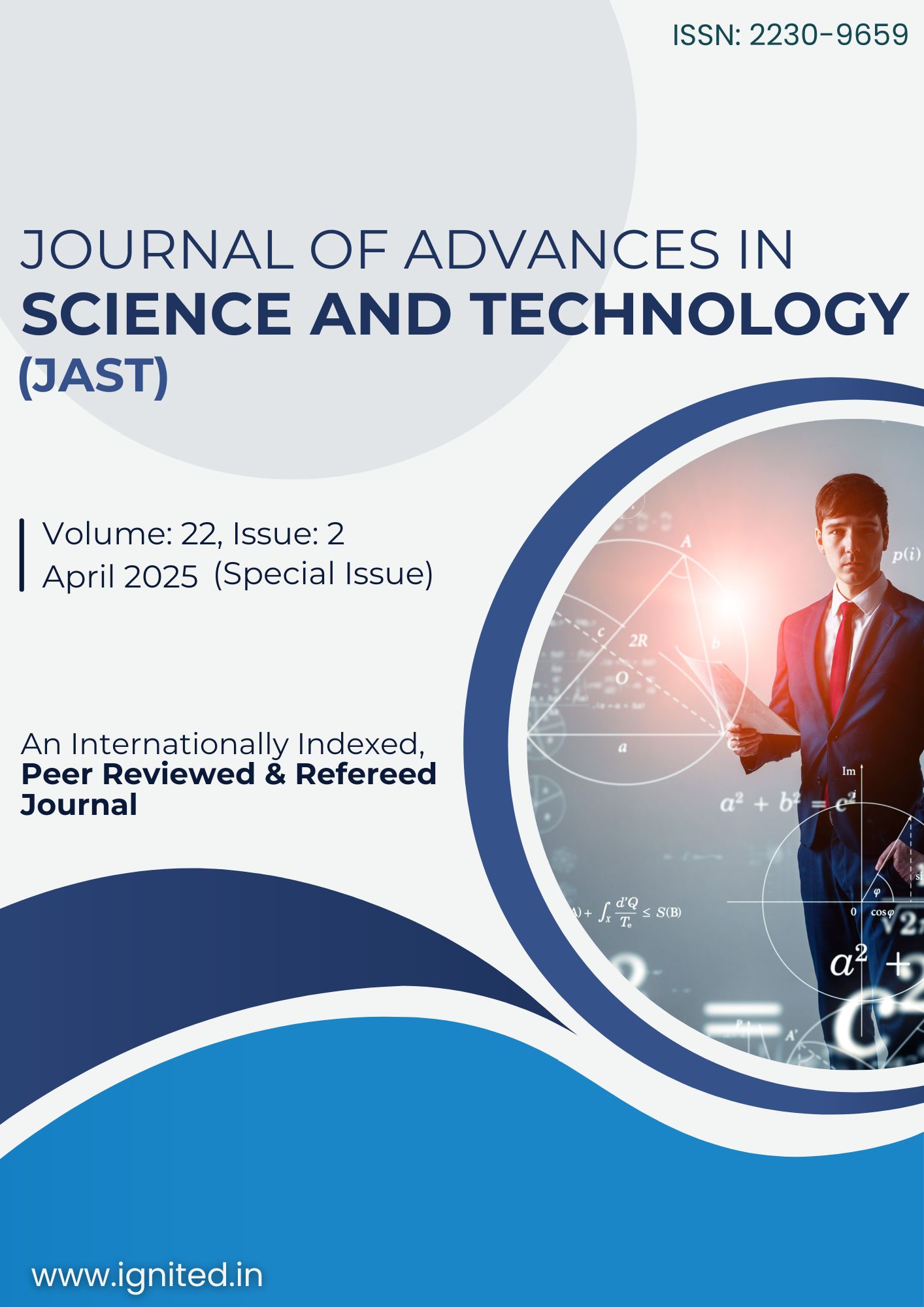Optical and morphological investigation of Y₂O₃:Tb³⁺ (1 mol%) and Bi³⁺ co-doped Y₂O₃:Tb³⁺ (1 mol%) nanoparticles
Main Article Content
Authors
Abstract
Y₂O₃:Tb³⁺ (1 mol%) and Bi³⁺ co-doped Y₂O₃:Tb³⁺ nanophosphors were synthesized via combustion method at 1000 °C. The synthesized samples were characterized using a number of techniques, including XRD, SEM, EDX, Elemental mapping, PL, and XPS. XRD and SEM for structural and morphological characterization, which verified phase purity and homogeneous morphology. According to photo-luminescence research, the 4f⁶ 5d¹ → 4f⁷ transition of Tb³⁺ is responsible for the broad excitation at 324 nm and the noticeable blue emission at 465 nm. Bi³⁺ and ions were successfully incorporated into the Y₂O₃ lattice, as confirmed by XPS, both of which maintained their trivalent oxidation states with little discernible distortion. These results demonstrate effective co-doping and imply improved luminescence through energy transfer processes with very small concentrations of rare-earth element.
Downloads
Article Details
Section
References
- Ropp R. C. (2004) Luminescence and the Solid State. Elsevier.
- Som S. et al. (2015) Synthesis of strong red-emitting Y₂O₃: Eu³⁺ phosphor by chemical routes: structural evolution, photometric properties, and Judd–Ofelt analysis. RSC Advances, 5, 70887-70898.
- Chen J. et al. (2008) Hydrothermal synthesis of ordered Y₂O₃:Eu³⁺ nanolamella architectures and their luminescent properties. Physica E: Low-Dimensional Systems and Nanostructures, 41, 304–308.
- Chi L. S. et al. (2005) Synthesis of Y₂O₃:Eu, Bi red phosphors by homogeneous co-precipitation and their photoluminescence behaviors. Journal of The Electrochemical Society, 152, J93.
- Zhang H. et al. (2015) Strategies for boosting phosphor luminescence efficiency via energy transfer. Chemical Society Reviews, 44, 362–376.
- Yu R. et al. (2009) Structural and luminescent properties of Bi-doped Y₂O₃:Tb³⁺ phosphors. Materials Letters, 63, 2212–2214.
- Yen W. M. et al. (2004) Inorganic Phosphors: Compositions, Preparation and Optical Properties. CRC Press, 496.
- Gupta S. K., et al. (2014) Structural and photoluminescence properties of Y₂O₃:Tb³⁺ nanophosphors. Journal of Luminescence, 145, 828–834.
- Wen X., et al. (2010) Synthesis and luminescent properties of Tb³⁺-doped Y₂O₃ nanophosphors via hydrothermal method. Journal of Rare Earths, 28, 903–907.
- Wang F., et al. (2010) Lanthanide-doped nanocrystals as luminescent probes for bioimaging. Chemical Society Reviews, 39, 1294–1308.
- F. et al. (2021) Synthesis, characterization and radioluminescence properties of erbium-doped yttria phosphors, International Journal of Minerals, Metallurgy and Materials, 28, 1983–1990.
- Wang Y. et al. (2002) Synthesis and luminescence of Y₂O₃:Tb nanocrystals. Journal of Materials Chemistry, 12, 1239–1241.
- Aruna S. T. et al. (2008) Combustion synthesis and nanomaterials. Current Opinion in Solid State and Materials Science, 12, 44–50.
- Chen G. et al. (2011). Enhanced luminescence in Bi³⁺/rare-earth-doped Y₂O₃ nanophosphors. Optical Materials, 33, 881–886.
- Xu X. et al. (2008). Energy transfer from Bi³⁺ to Tb³⁺ in Bi³⁺/Tb³⁺ co-doped phosphors. Journal of Alloys and Compounds, 456, 280–284.
- Chauhan V. et al. (2021). Bi³⁺-assisted luminescence in SrMoO₄: Sm³⁺ red phosphor. Journal of Rare Earths, 39, 1336-1343.
- Chen Z., et al. (2009). Microwave-induced solution combustion synthesis of nano-sized phosphors. Journal of Alloys and Compounds, 473, 13–16.
- Singh P. et al. (2008). In situ high temperature XRD studies of ZnO nanopowder prepared via cost effective ultrasonic mist chemical vapour deposition. Bulletin of Materials Science, 31,573-577.
- Lin-li, Z., Chang-xin, G., Jun-jing, Z., & Jun-tao, H. (2005) Photoluminescence of Eu(III)-Doped ZnO Nanopowder and Energy Transfer from ZnO to Eu(III) Ions. Chinese Physics Letters,22,1225.
- Pavitra E. et al. (2012) A novel strategy for controllable emissions from Eu3+ or Sm3+ ions co-doped SrY2O4:Tb3+ phosphors. Physical Chemistry Chemical Physics, 14, 11296–11307.
- Atuchin V. V. et al. (2014) Synthesis and spectroscopic properties of multiferroic β′-Tb2(MoO4)3. Optical Materials, 36, 1631–1635.
- De Oliveira R. S. et al. (2017) Tunable photoluminescence of nanostructured LaPO4:Eu3+/Tb3+ synthesized via a microwave-assisted ethylene glycol route. Ceramics International, 43, 8276–8283.
- Taikar D. R. et al. (2020). Study of energy transfer from Bi³⁺ to Tb³⁺ in Y₂O₃ phosphor and its application for W LED. Journal of Alloys and Compounds. 828, 154405
- Guyot, Y. et al. (2016). Assignment of Yb³⁺ energy levels in the C₂ and C₃ᵢ centers of Lu₂O₃ sesquioxide. Journal of Luminescence, 170, 513–519.
- Som S. K. et al. (2013). Influences of doping and annealing on the structural and photoluminescence properties of Y₂O₃ nanophosphors. Journal of Fluorescence, 23, 439–450.
- Luis M.B. et al. (2018) Luminescent and structural analysis of yttrium oxide doped with different percentages of terbium and dysprosium, to obtain different shades of green to yellow.Journal of Nanophotonics, 12, 026018.
- Masumoto K. et al. (2011) Luminescence characteristics and annealing effects of Tb doped AlBNO films for inorganic electroluminescence devices. Japanese Journal of Applied Physics, 50, 4S.
- Jafer R. M. et al. (2015) X-ray photoelectron spectroscopy and luminescent properties of Y₂O₃: Bi³⁺ phosphor. Applied Surface Science, 332 198-204.

